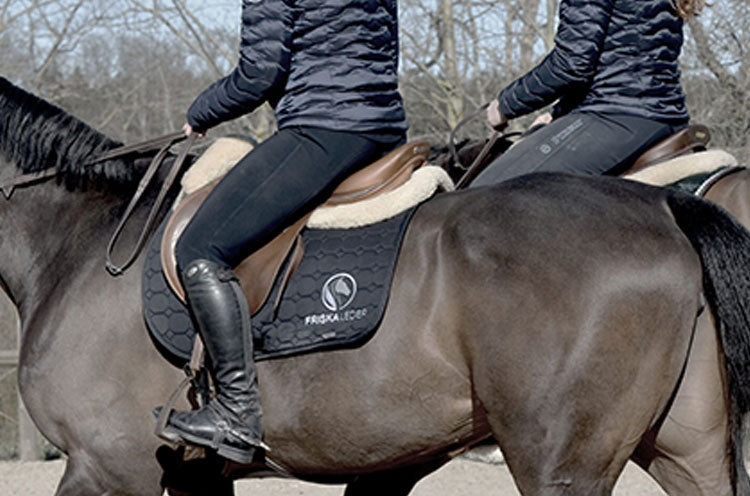The tricky stages of joint inflammation
Joint inflammation and lameness are the most common reasons why our horses have to be treated by a veterinarian. The trickiest thing about the disease is that it is periodically low-grade. This means that in various stages there can be a small inflammation and festering in the joint without the horse showing any clear symptoms of lameness. The risk is then that we continue to stress the joint as usual and trigger the inflammation to break out and become acute instead of it healing. These silent stages of inflammation make it extra important for us to get to know our horses' health well. Only then can we draw attention to the small deviations early on. It can be small signals such as reluctance to perform certain steps that are normally not a concern, or it can just be something as small as a difference in the gaze or wrinkles around the muzzle.
The vast majority of horses will get arthritis at some point in their lives.
Veterinarian Eva Skiöldebrand has told us that almost all horses used in the sport will get joint inflammation at least sometime during their career and that it is of the utmost importance to make sure that it heals one hundred percent before returning to normal training and competition again. Joint inflammation is the basis of arthrosis and osteoarthritis which causes chronic disease in the long run. This is why recovery is so important when the horse has been exposed to extra hard periods of training and competition to ensure that there is no low-grade inflammation waiting to flare up at the next intense period.
Even if you are careful with the recovery, it happens that the horse gets an acute joint inflammation with lameness as a result. It must then usually be treated by a veterinarian and receive an anti-inflammatory injection in the diseased joint. The injection often consists of high molecular weight hyaluronic acid. In some cases, one treatment is enough, but often two or more injections are needed for the horse to become lame.
The rehabilitation
When the horse is found to be unfit on a return visit, the rehabilitation phase is entered. You get a plan home with you and the start-up must be done according to agreement with your veterinarian. At this stage, it is important to remember what we wrote about above, that even if the horse is lame, there may still be a low-grade inflammation in the joint that must be given time and help to heal completely. If you get too eager at the start and are in too much of a hurry to get out on the competition tracks again, there is a great risk that the inflammation flares up again and then with a significantly longer recovery process and greater risk of chronic inflammatory stages.
Be patient and let the rehabilitation take its time!
Conquest – For horses in rehabilitation
Conquest was researched by a veterinarian precisely with the aim of supporting rehabilitation after joint inflammation. By reinforcing the rehabilitation work with a Conquest course, you optimize the conditions for completely healing the possibly remaining low-grade inflammation in the joint.
Conquest contains a high dose of high molecular hyaluronic acid and Boswellia Serrata. The high molecular weight of the hyaluronic acid promotes new formation of new healthy high molecular hyaluronic acid in the joint and Boswellia Serrata means that the hyaluronic acid is not broken down. It sounds complex, but simply put, you can say that both substances contribute to recreating a thick and viscous synovial fluid that allows the joint to function normally without risking damage to joints and bridge surfaces. The best thing about the combination is that both substances "trigger" each other so that they have an enhanced and better effect than if they had acted separately.
A course of Conquest lasts for 2 months. It begins with 8 days of Start Up treatment with extra high doses for fast and effective inflammation suppression and is followed by 50 days of Conquest Follow Up.
Hyaluronic acid
The substance is naturally present in the joint, but in case of inflammation it is broken down faster than normal and the synovial fluid tends to become thin and watery. It then loses its protective, lubricating and shock-absorbing properties and it is no longer able to transport waste products away from the joint. This is when galls occur.
Boswellia Serrata
Boswellia Serrata is extracted from the pods of the Indian Boswellia tree.
These two substances in precisely balanced amounts work very well together and produce synergistic effects, i.e. they reinforce each other so that the total effect is very high.
Conquest is recommended by veterinarians both for rehabilitative purposes but also as recovery after hard exertion to prevent possible flare-ups of joint inflammation. The starter's 96 hours.
Background
When veterinarian Eva Skiöldebrand was told in the 90s that veterinarians at the world's largest horse hospital, Rood & Riddle in Kentucky, had produced research results that showed that hyaluronic acid with the right molecular weight could be given in the feed and that it then actually reached the joints, something happened something with the preventive work around joint health on horses. The products Conquer 200Pro and Chondrogen 100Pro revolutionized the market as the first hyaluronic acid products for oral administration, finally there were products that could be used for preventive purposes.
Conquest is part of the Healthy Joints product group and was developed by a veterinarian to support the rehabilitation of horses that have undergone treatment for joint inflammation. It is also an effective recovery regimen for horses in intensive work, for example after the end of the competition season or a hard meeting."





Leave a comment
This site is protected by hCaptcha and the hCaptcha Privacy Policy and Terms of Service apply.